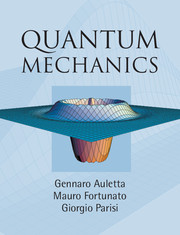Book contents
- Frontmatter
- Contents
- List of figures
- List of tables
- List of definitions, principles, etc.
- List of boxes
- List of symbols
- List of abbreviations
- Introduction
- Part I Basic features of quantum mechanics
- Part II More advanced topics
- Part III Matter and light
- Part IV Quantum information: state and correlations
- 14 Quantum theory of open systems
- 15 State measurement in quantum mechanics
- 16 Entanglement: non-separability
- 17 Entanglement: quantum information and computation
- Bibliography
- Author index
- Subject index
16 - Entanglement: non-separability
Published online by Cambridge University Press: 05 June 2012
- Frontmatter
- Contents
- List of figures
- List of tables
- List of definitions, principles, etc.
- List of boxes
- List of symbols
- List of abbreviations
- Introduction
- Part I Basic features of quantum mechanics
- Part II More advanced topics
- Part III Matter and light
- Part IV Quantum information: state and correlations
- 14 Quantum theory of open systems
- 15 State measurement in quantum mechanics
- 16 Entanglement: non-separability
- 17 Entanglement: quantum information and computation
- Bibliography
- Author index
- Subject index
Summary
In classical mechanics, two (or more) systems that do not interact – that do not exert any kind of force on each other – are completely separated (see Sec. 1.1), i.e. experiments performed locally on one of them cannot in any way influence experiments performed locally on the other. Quantum mechanics, on the other hand, admits that there can be a form of interdependence even in absence of physical interaction. This type of correlation goes under the name of entanglement (see Def. 5.1: p. 183). We already know that entanglement means non-factorizability of the state vector describing a system with at least two different degrees of freedom. In this chapter, we shall see that this may be the case also for systems that are very far away (space-like distant) from each other and we shall learn many interesting consequences of this state of affairs. Recent developments show that one may entangle even particles that have never interacted with each other.
The starting point of the following analysis is necessarily represented by the pioneering paper of Einstein, Podolsky, and Rosen, who inaugurated an incredible series of theoretical and experimental investigations right up to the present day that have confirmed the predictions of quantum mechanics. The “irony” of this history is that Einstein, Podolsky, and Rosen, EPR for short, aimed to present a definitive proof of the inconsistency of quantum mechanics relative to classical physical theory. In fact, they initiated one of the most prolific fields of modern science.
- Type
- Chapter
- Information
- Quantum Mechanics , pp. 567 - 627Publisher: Cambridge University PressPrint publication year: 2009



